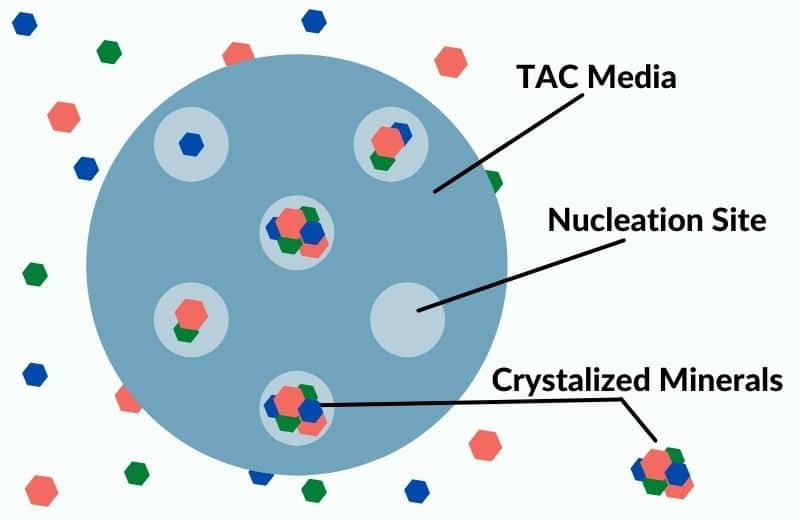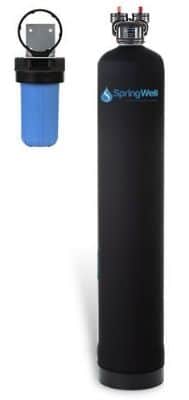Water conditioners may use various methods to achieve soft water, with the most popular being template-assisted crystallization, or TAC. Though it has a pretty daunting name, TAC isn’t as complicated as it seems.
If you’re looking for a simple explanation of this whole-home water conditioning process, you’ve come to the right place. Read on to learn more about TAC technology – how it works, the advantages and disadvantages of this method of scale prevention, and your possible TAC alternatives.
Table of Contents
💠 What is TAC Technology?
Back in the day, if you wanted a scale treatment solution that didn’t use salt, you’d have to opt for a system that used an electric current to alter the composition of hard water minerals, known as a magnetic water softener. The problem with this water treatment option was that it was very difficult to gauge whether it was actually working.
Enter template-assisted crystallization (TAC for short). Also referred to as nucleation assisted crystallization, this salt-free softening method provides a similar outcome but uses a different method to get there.
It’s the newest and most popular softener alternative on the market, and, rather than removing calcium and magnesium minerals from water entirely, TAC units simply convert them into a crystallized form.
💬 How does Template Assisted Crystallization Treat Hard Water?
To get a little more technical, template assisted crystallization (or nucleation assisted crystallization) units typically consist of a single tank that contains a specially-treated resin bed.
This bed catches calcium and magnesium hardness minerals as water flows through the tank.
Inside the resin are microscopic nucleation sites, where the minerals are crystallized, or given a crystal-like outer coating that leaves them suspended in the water. These crystals are unable to stick to surfaces to form scale.

🤔Does Template Assisted Crystallization Work?
If you’ve even done the smallest amount of research into TAC, you’ll know that it’s been the subject of controversy over the years.
Manufacturers of salt-using softeners point out that with template assisted crystallization, there’s no way to actually prove that the water treatment process has even worked, as your water still contains calcium & magnesium and is therefore still technically hard.
However, while a water test won’t tell you whether a whole house TAC system has worked, the proof is in the pudding, as they say.
Once you install a TAC salt-free water softener, you’ll no longer notice any new scale formation in your pipes, plumbing and fixtures.
Your drinking water will still taste the same, but the hard water minerals suspended in the water will no longer be able to cause limescale issues.
👍 Advantages of Salt-free TAC Water Conditioners
There are many reasons why you may choose to go for a template assisted crystallization water conditioner as an alternative to a standard salt-based water softener. Some of the benefits of these water systems include:
Healthy Minerals Retained
TAC technology simply converts magnesium and calcium into microscopic crystals, rather than removing them entirely from water. These hardness minerals are essential for human health, and can also improve the taste of water, so it’s definitely a bonus that TAC retains these particulates while preventing scale formation.
More Affordable Upkeep
While a salt-based water softener requires salt to operate, TAC softener technologies typically only require a special resin bed to operate. As this resin usually lasts for more than 8 years, TAC units require far less maintenance than a salt-based water softener, which will need regular salt top-ups.
Reduces Scale
Presumably, you’re looking at water softeners because you want to tackle the common household problem of limescale. A TAC water treatment alternative is capable of reducing more than 90% of scale without slowing down your water flow rate, so it does the job you’re likely hoping it can do!
Protects Your Applications
Because a descaler can convert hard water minerals into crystals that can’t form scale on surfaces, it’ll protect your home’s appliances, such as water heaters, dishwashers and washing machines.
Easier Install
While salt-based water softeners require a slightly more invasive installation, TAC units only have a single tank, making them slightly easier to set up. You should be able to set up a TAC softener system yourself without having to pay extra for a plumber.

👎 Disadvantages of TAC
More Difficult to See That It’s Working
Many people like the reassurance of being able to test their water to check that their form of treatment is working. But because a TAC water conditioner just converts magnesium and calcium to crystals rather than removing them from water, there’s no good way to test that the system is living up to expectations.
No NSF Certification
Because there’s no way to prove the performance of template assisted crystallization technologies, the NSF doesn’t currently offer certification for these systems. The NSF is a third-party testing body that essentially helps reassure buyers that a product is tested and proven capable of doing what it’s advertised to do. If an NSF certification is important to you, you will need to look at an alternative hard water solution.
May Not Entirely Prevent Scale
Template assisted crystallization treatment offers a high level of performance, reducing more than 90% of scale formation – but it doesn’t prevent scale formation entirely. Ion exchange water softeners are likely to give you a slightly better result.
🔠 Alternatives to TAC For Water Softening
Whether you’ve determined that template assisted crystallization isn’t for you or you’re just keen to know your options, some of the related water softening solutions include the following:
Ion Exchange Water Softeners
Ion exchange water softeners are some of the best available for tackling hard water. As the name suggests, these systems use a process called ion exchange to swap out calcium and magnesium for another ion, usually sodium.
The benefits of this conventional anti-hardness solution are obvious: because ion exchange softeners can remove hardness mineral ions entirely, you’ll be able to perform testing to get physical proof that the process is working. Ion exchange is the most effective option, too, so your mineral deposits will be completely eliminated from your home’s appliances, including water heaters.
Keep in mind, however, that this hard water treatment requires regular salt top-ops, and you’ll need to replace the media once every 6-8 years. Because of the slightly lengthier softening method, your water flow may also be affected noticeably by this kind of water softener, especially if your water pressure is on the lower side to begin with. Additionally, while ion exchange devices are relatively affordable, they’re not as cheap as some of the options on the market (see below).
Magnetic Descalers
Magnetic descalers are the original hard water treatment alternative to conventional ion exchange water softeners. These devices don’t use media to treat water, and most don’t even have a tank – instead, they’re installed around pipes to treat water as it flows through.
Research into magnetic descalers is still relatively vague, but manufacturers say that these systems can tackle hard water by creating a strong electromagnetic field. This changes the composition of hardness mineral ions, preventing them from being able to form scale.
This type of descaler tends to be the cheapest option, as well as being the cheapest to maintain, as there’s no media to replace or salt to top up. It’s also the easiest to install, providing you have space around your pipes to set up the magnets. Because it’s tankless, it won’t affect the flow of your water at all. However, many people are hesitant to purchase an electromagnetic descaler because research so far is lacking.
The only way to check that your water is being effectively treated is to check for mineral deposits on applications like water heaters. If this testing shows that your surfaces are free of any new scale going forward, you can determine that your device is working.
